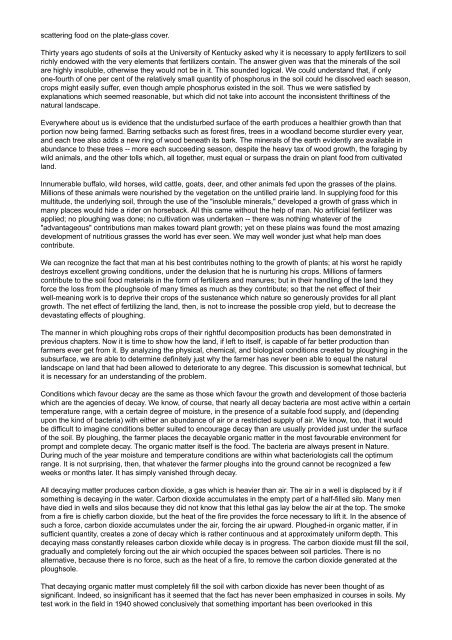Ploughman's Folly Ploughman's Folly - EcoPort
Ploughman's Folly Ploughman's Folly - EcoPort
Ploughman's Folly Ploughman's Folly - EcoPort
Create successful ePaper yourself
Turn your PDF publications into a flip-book with our unique Google optimized e-Paper software.
scattering food on the plate-glass cover.<br />
Thirty years ago students of soils at the University of Kentucky asked why it is necessary to apply fertilizers to soil<br />
richly endowed with the very elements that fertilizers contain. The answer given was that the minerals of the soil<br />
are highly insoluble, otherwise they would not be in it. This sounded logical. We could understand that, if only<br />
one-fourth of one per cent of the relatively small quantity of phosphorus in the soil could he dissolved each season,<br />
crops might easily suffer, even though ample phosphorus existed in the soil. Thus we were satisfied by<br />
explanations which seemed reasonable, but which did not take into account the inconsistent thriftiness of the<br />
natural landscape.<br />
Everywhere about us is evidence that the undisturbed surface of the earth produces a healthier growth than that<br />
portion now being farmed. Barring setbacks such as forest fires, trees in a woodland become sturdier every year,<br />
and each tree also adds a new ring of wood beneath its bark. The minerals of the earth evidently are available in<br />
abundance to these trees -- more each succeeding season, despite the heavy tax of wood growth, the foraging by<br />
wild animals, and the other tolls which, all together, must equal or surpass the drain on plant food from cultivated<br />
land.<br />
Innumerable buffalo, wild horses, wild cattle, goats, deer, and other animals fed upon the grasses of the plains.<br />
Millions of these animals were nourished by the vegetation on the untilled prairie land. In supplying food for this<br />
multitude, the underlying soil, through the use of the "insoluble minerals," developed a growth of grass which in<br />
many places would hide a rider on horseback. All this came without the help of man. No artificial fertilizer was<br />
applied; no ploughing was done; no cultivation was undertaken -- there was nothing whatever of the<br />
"advantageous" contributions man makes toward plant growth; yet on these plains was found the most amazing<br />
development of nutritious grasses the world has ever seen. We may well wonder just what help man does<br />
contribute.<br />
We can recognize the fact that man at his best contributes nothing to the growth of plants; at his worst he rapidly<br />
destroys excellent growing conditions, under the delusion that he is nurturing his crops. Millions of farmers<br />
contribute to the soil food materials in the form of fertilizers and manures; but in their handling of the land they<br />
force the loss from the ploughsole of many times as much as they contribute; so that the net effect of their<br />
well-meaning work is to deprive their crops of the sustenance which nature so generously provides for all plant<br />
growth. The net effect of fertilizing the land, then, is not to increase the possible crop yield, but to decrease the<br />
devastating effects of ploughing.<br />
The manner in which ploughing robs crops of their rightful decomposition products has been demonstrated in<br />
previous chapters. Now it is time to show how the land, if left to itself, is capable of far better production than<br />
farmers ever get from it. By analyzing the physical, chemical, and biological conditions created by ploughing in the<br />
subsurface, we are able to determine definitely just why the farmer has never been able to equal the natural<br />
landscape on land that had been allowed to deteriorate to any degree. This discussion is somewhat technical, but<br />
it is necessary for an understanding of the problem.<br />
Conditions which favour decay are the same as those which favour the growth and development of those bacteria<br />
which are the agencies of decay. We know, of course, that nearly all decay bacteria are most active within a certain<br />
temperature range, with a certain degree of moisture, in the presence of a suitable food supply, and (depending<br />
upon the kind of bacteria) with either an abundance of air or a restricted supply of air. We know, too, that it would<br />
be difficult to imagine conditions better suited to encourage decay than are usually provided just under the surface<br />
of the soil. By ploughing, the farmer places the decayable organic matter in the most favourable environment for<br />
prompt and complete decay. The organic matter itself is the food. The bacteria are always present in Nature.<br />
During much of the year moisture and temperature conditions are within what bacteriologists call the optimum<br />
range. It is not surprising, then, that whatever the farmer ploughs into the ground cannot be recognized a few<br />
weeks or months later. It has simply vanished through decay.<br />
All decaying matter produces carbon dioxide, a gas which is heavier than air. The air in a well is displaced by it if<br />
something is decaying in the water. Carbon dioxide accumulates in the empty part of a half-filled silo. Many men<br />
have died in wells and silos because they did not know that this lethal gas lay below the air at the top. The smoke<br />
from a fire is chiefly carbon dioxide, but the heat of the fire provides the force necessary to lift it. In the absence of<br />
such a force, carbon dioxide accumulates under the air, forcing the air upward. Ploughed-in organic matter, if in<br />
sufficient quantity, creates a zone of decay which is rather continuous and at approximately uniform depth. This<br />
decaying mass constantly releases carbon dioxide while decay is in progress. The carbon dioxide must fill the soil,<br />
gradually and completely forcing out the air which occupied the spaces between soil particles. There is no<br />
alternative, because there is no force, such as the heat of a fire, to remove the carbon dioxide generated at the<br />
ploughsole.<br />
That decaying organic matter must completely fill the soil with carbon dioxide has never been thought of as<br />
significant. Indeed, so insignificant has it seemed that the fact has never been emphasized in courses in soils. My<br />
test work in the field in 1940 showed conclusively that something important has been overlooked in this






